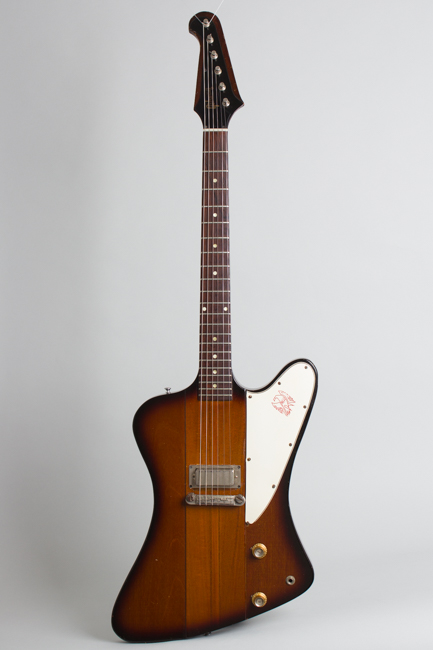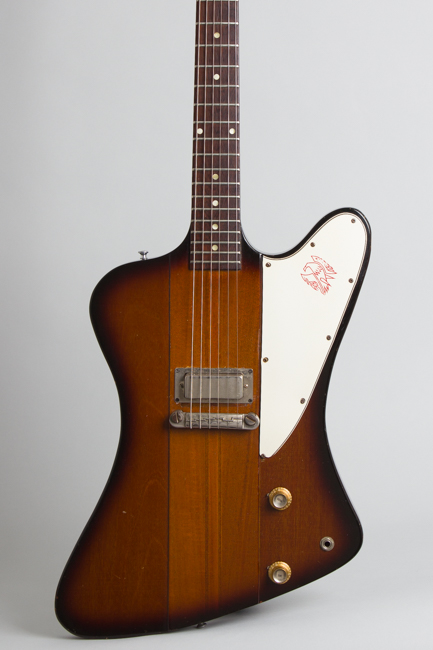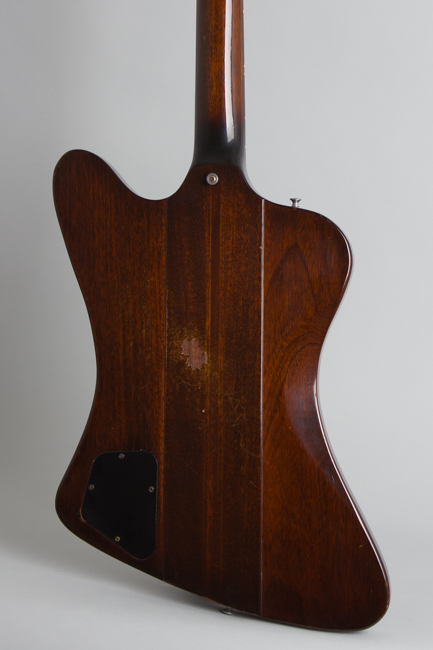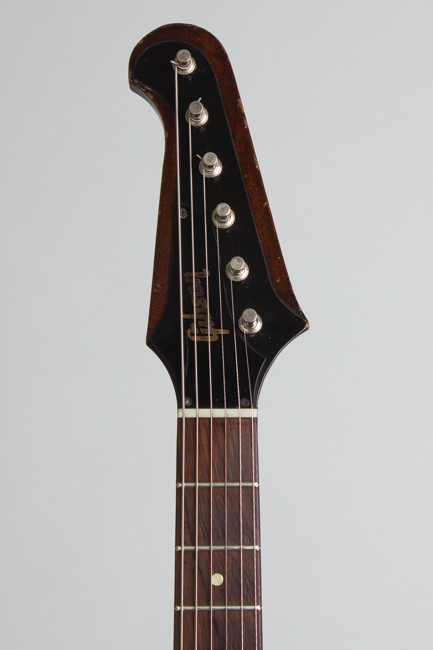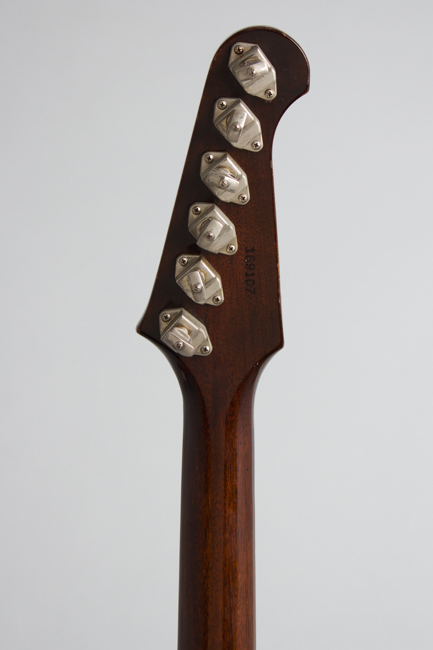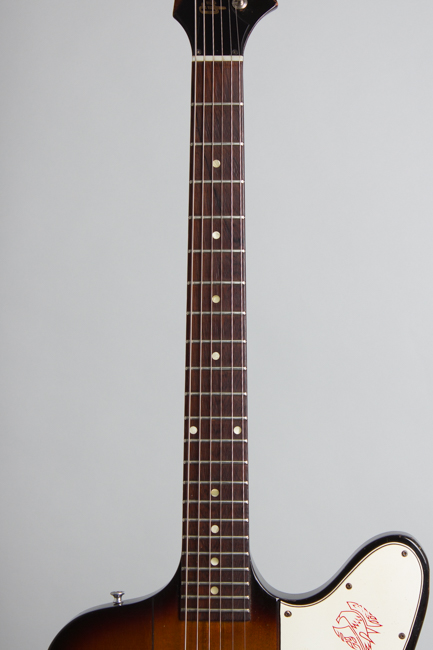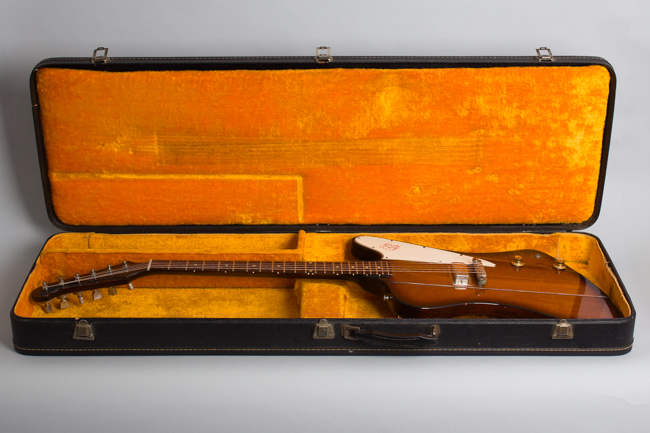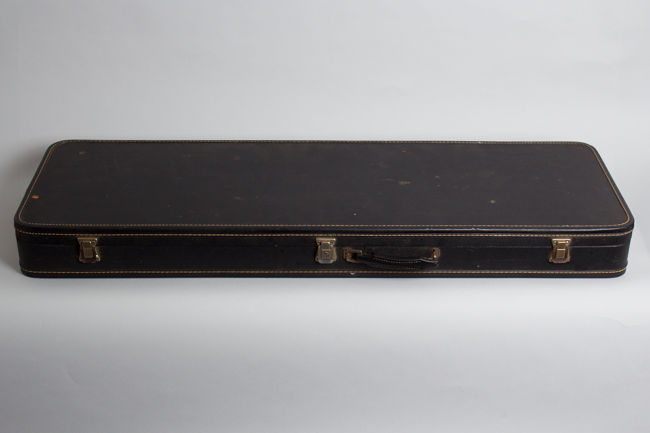Gibson Firebird I Solid Body Electric Guitar (1964)
Gibson Firebird I Model Solid Body Electric Guitar (1964), made in Kalamazoo, Michigan, serial # 169107, sunburst lacquer finish, laminated mahogany body and neck, rosewood fingerboard, original black hard shell case.
This is a lightly restored 1964 example of the rare original "Reverse" body Gibson Firebird I. At some point a full-sized humbucking pickup was mounted; the slightly enlarged rout in the top has been patched and an original 1960s Firebird pickup re-installed. The guitar looks, sounds and plays as fully original, with only a small section of patched-in wood added along the back edge of the pickup ring visible to indicate it was ever modified.
The Firebird I is one of the rarer of the 'bird series, a starkly minimalist design originally issued with only a single bridge pickup and no vibrato system. In 1963-4 there were a number of student instruments available with both those features, and the fairly expensive Firebird I did not sell nearly as well as the mid-line III model, so is now much scarcer. Gibson usually expected the lowest priced model in any line to be the best seller, but the Firebird story did not fit that pattern.
This entire unique instrument line was originally sadly short-lived, introduced in late 1963 and discontinued after the mid-1965 NAMM show. The original pattern Firebird is considered a Gibson classic with its futuristic sweeping lines and innovative through-body neck construction, but the limited production time meant they barely had a chance to get established in the market before being replaced by the more conventional "non-reverse" versions. The originals have been a sought-after guitar since, re-issued, revamped but never really equaled in the Gibson pantheon.
The Firebird I was the lowest model of the original 'birds with a distinctive uncluttered layout, one of the sleekest guitars of the 1960s. The unbound, dot inlaid fingerboard is the defining element but the early models had one special Firebird mini-humbucking pickup in the treble position and Gibson's simple stop tail bridge. The neck is a bit bigger than the contemporary SG series with a comfortable round-backed profile and faired-in heel. This is topped by the unique "backwards" headstock with individual Kluson banjo tuners. All the (minimal) hardware is nickel plated. The pickguard covers the entire forward lower body horn, decorated with a nifty Firebird emblem.
Practically everything about the original Firebirds was unique; the long laminated neck-through-body centerpiece with "wings" glued to the sides, the fluid body shape with the longer lower cutaway horn and that headstock with the tuner buttons hidden from the front with the low E farthest from the nut. They hardly had a chance to catch on with players before being drastically revamped. A threatened lawsuit from Fender is often cited as the reason, but more likely the complex design simply proved uneconomical to produce. The elaborate sculpting of the body and headstock and the eccentric neck-through construction make for a beautiful instrument, but one that proved difficult for Gibson to build on a cost-effective basis especially this lower-priced Firebird I. The list price in 1964 was $215, plus another $46 for the only issued large hardshell case. By contrast the single-pickup SG junior was only $165, with a $15 chipboard case available. That difference represented a lot of lawn-mowing money in 1964!
As a result only 497 "Reverse" Firebird I's were shipped in 1964, along with 80 in '63 and an unknown number in the first half of 1965. The FB I was modified by mid-year to carry two P-90 pickups, and after that June the new cheaper "non-reverse" models began to ship in much larger numbers. These listed at $189.50 but offered twin P-90s and a Gibson Vibrola as standard, features "the kids" wanted in the mid-60s. Of the approximately 1000 (maximum) Reverse FB I's ever built many have suffered cracks in the headstock area and/or been played heavily or more heavily modified.
The I has a particular association with Eric Clapton, who played one extensively in the latter days of Cream and is also identified with Steven Stills in the 1970s. This beautiful minimalist liquid sculpture guitar is a splendid survivor, now neatly restored to its original configuration and as a great playing instrument. While not the most versatile of the original 'birds with its single bridge pickup this is a real screamer with a unique and powerful sound.
Overall length is 45 in. (114.3 cm.), 13 1/2 in. (34.3 cm.) wide at lower bout, and 1 1/8 in. (2.9 cm.) in depth, measured at side of rim. Scale length is 24 3/4 in. (629 mm.). Width of nut is 1 11/16 in. (43 mm.).
This guitar shows only some light general wear overall and apart from the pickup restoration remains nicely original with no other damage or repair. The finish shows some light checking and some small chips and dings, with one deeper area of belt buckle wear in the middle of the back into through the finish. The long headstock has some of the common dings and chips but overall this 'bird's finish is better preserved than many. There is a small spot of hardened shmutz just above the volume control. This guitar has the small "2" on the back of the headstock marking it as a factory second, though no obvious reason can be seen.
The most common Firebird malady is absent -- the neck has NEVER been cracked or broken. The back wall of the pickup cavity has been patched back in from having been enlarged; this is inconspicuous, neatly done but visible on close inspection. There is some typical pickguard shrinkage, with the screws pulling a bit and cracks at the rearmost screws with the lower tip fully detached, and the screw moved inwards to compensate. The engraved and painted bird emblem on the pickguard retains most of its red pigment, with less loss than many. The front tip of the truss rod cover is cracked at the screw. The nickel plating shows typical wear but remains largely intact, with some typical rubbed-away spots from contact on the tailpiece bolts.
The original large frets have been lightly polished, they and the fingerboard have very little subsequent wear and this is an excellent player, with the typical snarly single-pickup Firebird sound. It includes the yellow-lined black rectangular original case, relatively clean and fully solid. The Reverse Firebird I's just do not turn up that much, and this neat restoration to original is a great sounding and playing example of this super stylish minimalist Gibson classic. Overall Very Good Condition.
This is a lightly restored 1964 example of the rare original "Reverse" body Gibson Firebird I. At some point a full-sized humbucking pickup was mounted; the slightly enlarged rout in the top has been patched and an original 1960s Firebird pickup re-installed. The guitar looks, sounds and plays as fully original, with only a small section of patched-in wood added along the back edge of the pickup ring visible to indicate it was ever modified.
The Firebird I is one of the rarer of the 'bird series, a starkly minimalist design originally issued with only a single bridge pickup and no vibrato system. In 1963-4 there were a number of student instruments available with both those features, and the fairly expensive Firebird I did not sell nearly as well as the mid-line III model, so is now much scarcer. Gibson usually expected the lowest priced model in any line to be the best seller, but the Firebird story did not fit that pattern.
This entire unique instrument line was originally sadly short-lived, introduced in late 1963 and discontinued after the mid-1965 NAMM show. The original pattern Firebird is considered a Gibson classic with its futuristic sweeping lines and innovative through-body neck construction, but the limited production time meant they barely had a chance to get established in the market before being replaced by the more conventional "non-reverse" versions. The originals have been a sought-after guitar since, re-issued, revamped but never really equaled in the Gibson pantheon.
The Firebird I was the lowest model of the original 'birds with a distinctive uncluttered layout, one of the sleekest guitars of the 1960s. The unbound, dot inlaid fingerboard is the defining element but the early models had one special Firebird mini-humbucking pickup in the treble position and Gibson's simple stop tail bridge. The neck is a bit bigger than the contemporary SG series with a comfortable round-backed profile and faired-in heel. This is topped by the unique "backwards" headstock with individual Kluson banjo tuners. All the (minimal) hardware is nickel plated. The pickguard covers the entire forward lower body horn, decorated with a nifty Firebird emblem.
Practically everything about the original Firebirds was unique; the long laminated neck-through-body centerpiece with "wings" glued to the sides, the fluid body shape with the longer lower cutaway horn and that headstock with the tuner buttons hidden from the front with the low E farthest from the nut. They hardly had a chance to catch on with players before being drastically revamped. A threatened lawsuit from Fender is often cited as the reason, but more likely the complex design simply proved uneconomical to produce. The elaborate sculpting of the body and headstock and the eccentric neck-through construction make for a beautiful instrument, but one that proved difficult for Gibson to build on a cost-effective basis especially this lower-priced Firebird I. The list price in 1964 was $215, plus another $46 for the only issued large hardshell case. By contrast the single-pickup SG junior was only $165, with a $15 chipboard case available. That difference represented a lot of lawn-mowing money in 1964!
As a result only 497 "Reverse" Firebird I's were shipped in 1964, along with 80 in '63 and an unknown number in the first half of 1965. The FB I was modified by mid-year to carry two P-90 pickups, and after that June the new cheaper "non-reverse" models began to ship in much larger numbers. These listed at $189.50 but offered twin P-90s and a Gibson Vibrola as standard, features "the kids" wanted in the mid-60s. Of the approximately 1000 (maximum) Reverse FB I's ever built many have suffered cracks in the headstock area and/or been played heavily or more heavily modified.
The I has a particular association with Eric Clapton, who played one extensively in the latter days of Cream and is also identified with Steven Stills in the 1970s. This beautiful minimalist liquid sculpture guitar is a splendid survivor, now neatly restored to its original configuration and as a great playing instrument. While not the most versatile of the original 'birds with its single bridge pickup this is a real screamer with a unique and powerful sound.
Overall length is 45 in. (114.3 cm.), 13 1/2 in. (34.3 cm.) wide at lower bout, and 1 1/8 in. (2.9 cm.) in depth, measured at side of rim. Scale length is 24 3/4 in. (629 mm.). Width of nut is 1 11/16 in. (43 mm.).
This guitar shows only some light general wear overall and apart from the pickup restoration remains nicely original with no other damage or repair. The finish shows some light checking and some small chips and dings, with one deeper area of belt buckle wear in the middle of the back into through the finish. The long headstock has some of the common dings and chips but overall this 'bird's finish is better preserved than many. There is a small spot of hardened shmutz just above the volume control. This guitar has the small "2" on the back of the headstock marking it as a factory second, though no obvious reason can be seen.
The most common Firebird malady is absent -- the neck has NEVER been cracked or broken. The back wall of the pickup cavity has been patched back in from having been enlarged; this is inconspicuous, neatly done but visible on close inspection. There is some typical pickguard shrinkage, with the screws pulling a bit and cracks at the rearmost screws with the lower tip fully detached, and the screw moved inwards to compensate. The engraved and painted bird emblem on the pickguard retains most of its red pigment, with less loss than many. The front tip of the truss rod cover is cracked at the screw. The nickel plating shows typical wear but remains largely intact, with some typical rubbed-away spots from contact on the tailpiece bolts.
The original large frets have been lightly polished, they and the fingerboard have very little subsequent wear and this is an excellent player, with the typical snarly single-pickup Firebird sound. It includes the yellow-lined black rectangular original case, relatively clean and fully solid. The Reverse Firebird I's just do not turn up that much, and this neat restoration to original is a great sounding and playing example of this super stylish minimalist Gibson classic. Overall Very Good Condition.
